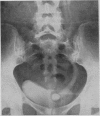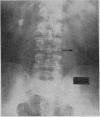Abstract
Immediate steps in the treatment of ureteral stone, beginning with the often acute onset, are relief of pain, urinalysis (including Gram stain), forcing fluids, examination of urine for the stone and urography at the earliest feasible time. If the stone causes continual pain or appears unlikely to be passed safely, it should be removed—with a cystoscope if possible; if not, by operation which may be done while the patient is still under anesthesia.
To combat further stone formation a large fluid intake should be maintained, the extracted stone analyzed, an acid ash diet prescribed, serum calcium and phosphorus measured, urinary stasis corrected and urinary infection and distant foci of infection cured. Vitamin A, aluminum gels and particularly hyaluronidase appear promising as preventives to stone formation.
Full text
PDF





Images in this article
Selected References
These references are in PubMed. This may not be the complete list of references from this article.
- BUTT A. J., HAUSER E. A., SEIFTER J. Medical management of renal lithiasis; increasing the protective urinary colloids with hyaluronidase. Calif Med. 1952 Mar;76(3):123–129. [PMC free article] [PubMed] [Google Scholar]
- SHORR E., CARTER A. C. Aluminum gels in the management of renal phosphatic calculi. J Am Med Assoc. 1950 Dec 30;144(18):1549–1556. doi: 10.1001/jama.1950.02920180013005. [DOI] [PubMed] [Google Scholar]
- VERMEULEN C. W., RAGINS H. D., GROVE W. J., GOETZ R. Experimental urolithiasis. III. Prevention and dissolution of calculi by alteration of urinary pH. J Urol. 1951 Jul;66(1):1–5. doi: 10.1016/S0022-5347(17)74306-6. [DOI] [PubMed] [Google Scholar]









